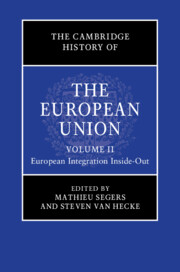Book contents
- The Cambridge History of the European Union
- The Cambridge History of the European Union
- The Cambridge History of the European Union
- Copyright page
- Contents
- Figures
- Tables
- Contributors to Volume II
- Acknowledgements
- Abbreviations
- Reflections on the History and Historiography of European Integration
- Part I Milestones: Treaties and Treaty Changes
- 1 Early Forms of European Unity
- 2 From Messina and Rome to the Single European Act
- 3 The Making of the European Union
- 4 From Maastricht and Copenhagen to Amsterdam and Nice
- 5 The Constitution Project, Lisbon and Beyond
- 6 Moving beyond British Exceptionalism
- Part II Instruments of Integration
- Part III Narratives and Outcomes
- Index
- References
1 - Early Forms of European Unity
from Part I - Milestones: Treaties and Treaty Changes
Published online by Cambridge University Press: 12 October 2023
- The Cambridge History of the European Union
- The Cambridge History of the European Union
- The Cambridge History of the European Union
- Copyright page
- Contents
- Figures
- Tables
- Contributors to Volume II
- Acknowledgements
- Abbreviations
- Reflections on the History and Historiography of European Integration
- Part I Milestones: Treaties and Treaty Changes
- 1 Early Forms of European Unity
- 2 From Messina and Rome to the Single European Act
- 3 The Making of the European Union
- 4 From Maastricht and Copenhagen to Amsterdam and Nice
- 5 The Constitution Project, Lisbon and Beyond
- 6 Moving beyond British Exceptionalism
- Part II Instruments of Integration
- Part III Narratives and Outcomes
- Index
- References
Summary
When did the first institutional forms of contemporary European unity emerge? There are essentially two approaches to answering this question. The first is to take the perspective of poets, writers and intellectuals. The second is to consider the projects and achievements of politicians. If we take the first approach, we must refer to all thinkers of European consciousness who imagined European unity, from the Abbé de Saint-Pierre and Victor Hugo to Émile Mayrisch and, more recently, Stefan Zweig. If we take the second, we must focus instead on institutional forms of unity, the ways in which citizens participate in it, and then assess its effects. We must present the most effective agents of unity, and explain their reasons for taking action.
- Type
- Chapter
- Information
- The Cambridge History of the European Union , pp. 29 - 59Publisher: Cambridge University PressPrint publication year: 2023



